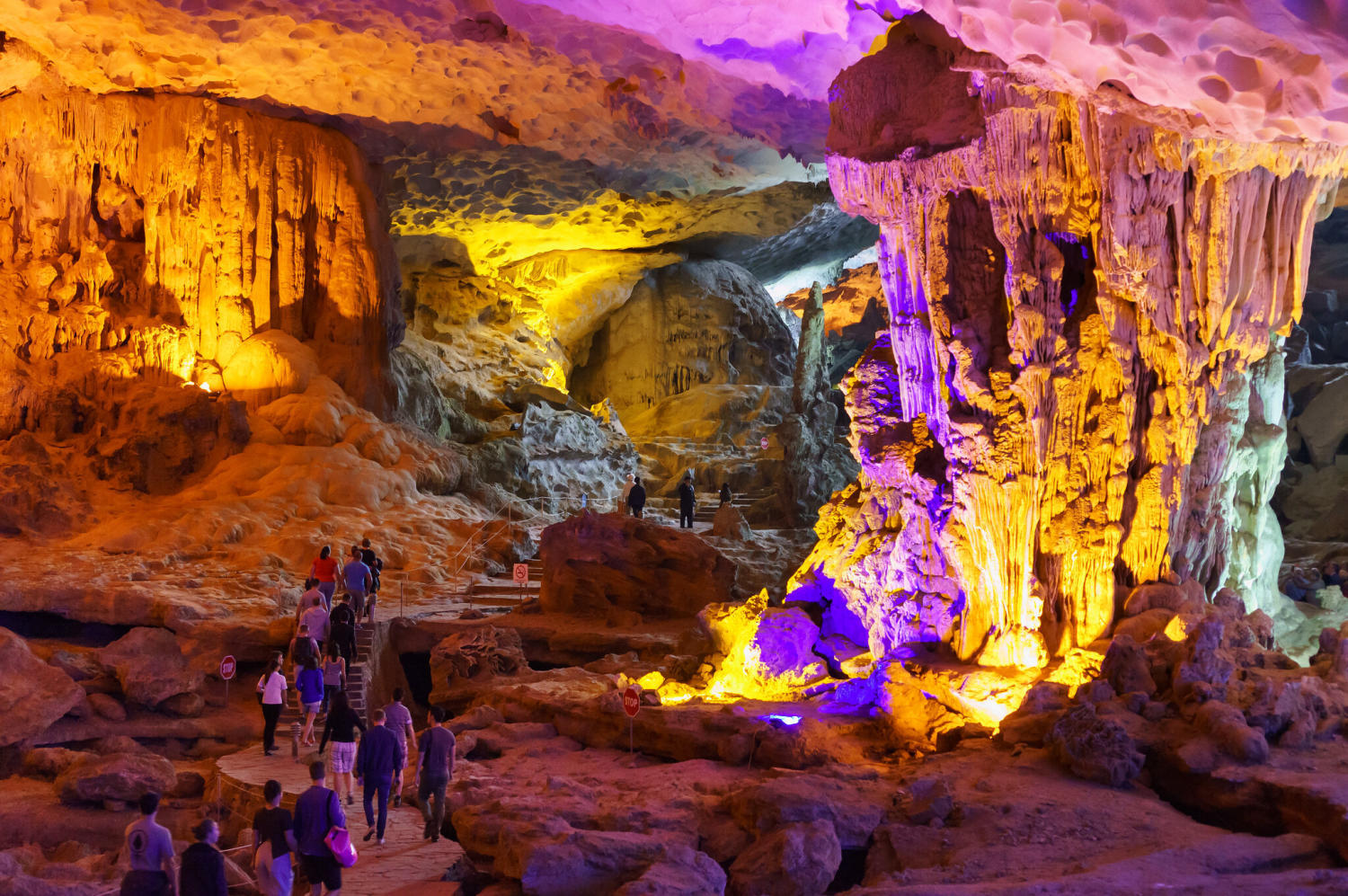SUNG SOT CAVE: THE ‘SURPRISING’ STORY BEHIND HA LONG BAY’S LARGEST CAVE
Of all of Ha Long’s caves, Sung Sot Cave is not only the largest but also perhaps the most renowned and likely the most visited.
Among the 1,969 sunken limestone towers submerged in the indigo waters of Ha Long Bay, there exists a series of ancient caves and grottoes. Many of these caves, however, remain unexplored. To date, there are 59 caves listed on the official registry. This number includes the recent discovery of 23 ‘new’ caves, all of which play a special role in Ha Long Bay’s distinctive ecosystem. Undoubtedly, the most famous of them all is Sung Sot Cave, which has rightfully earned its near-legendary status among visitors to this world-famous bay.

Sung Sot Cave
Location
Sung Sot Cave is the center of Ha Long Bay. It is located on Bo Hon Island. This island is close to several famous attractions. Nearby sites include Titov Island, Bo Nau Grotto, Me Cung Cave, and Luon Cave.
Bo Hon Island is one of the largest in the area. Its resident cave is also quite large. Trinh Nu Cave is also on this island. It features folklore tied to Ha Long Bay. The story involves estranged lovers and a tragic ending. You can read more about that here.
History & Formation of Sung Sot Cave
Sung Sot Cave was allegedly first discovered by the French in 1901. They took it upon themselves to name it “Grotte des Surprises,” or Surprising Cave, due to its ‘surprising’ beauty. However, this name did not catch on until a good 40 years later. The cave welcomed its first visitors in 1993, which was merely one year before Ha Long Bay received its first designation as a UNESCO World Heritage site.
From 520 to 470 million BC, Ha Long Bay experienced intense tectonic plate movements, along with severe rainfall and flooding. These conditions led to the formation of underwater mountains. Millions of years later, the Ha Long Bay area began to undergo a period of extreme heat and drought.
This change in weather patterns ultimately contributed to the emergence of the thick limestone formations we can still see today. Furthermore, the steady erosion of these sea mountains eventually resulted in the much-coveted caves of Ha Long Bay. Additionally, the advancement of the sea and its effects on cave formation can be observed on the ceilings, where a ripple-like pattern is often visible.
What You’ll See at Sung Sot Cave
There’s a small dock at the bottom of Bo Hon Island. Here, you’ll dismount your boat. Then, begin the climb up about 100 steps to Sung Sot Cave. The cave covers 10,000 square meters. That’s twice the size of the White House. It is about 30 meters high and has a 500-meter long passage. This is good news for those who are claustrophobic.
The interior has two caverns. The first is a small amphitheater space. It connects to a larger cavern next door. This larger space can hold over 1,000 people. They provide endless material for local legends and lore.
Folklore
Appointing recognizable shapes, animals, and patterns to cave formations is a beloved tradition in Ha Long Bay. A generous stretch of the imagination is often needed, but it’s part of the fun. A knowledgeable tour guide can enhance the experience.
During your visit, a stalactite may resemble a horse or a long sword. You might see it if you squint. These figures relate to the legend of Thanh Giong, a famous figure in Vietnamese folklore. He left these items to protect Ha Long Bay from evil demons.
Other recognizable formations include mammoths, elephants, seals, flowers, and a general with his troops.
Whether or not you see a mammoth, it’s hard not to be captivated by this place.
How to Get There
The best way to see Ha Long Bay has always been by boat. Among the numerous cruise companies that tour through the bay, a pretty large amount will visit Sung Sot Cave. Get in touch with us if you want to book a cruise visiting Sung Sot Cave!
Please don’t hesitate to contact us if you have any concerns: Click
Best Cruise visiting Sung Sot Cave